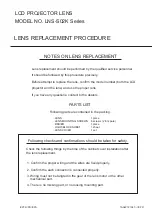Reviews:
No comments
Related manuals for XScale Core
voicelive rack
Brand: TC-Helicon Pages: 18

01A99-0200
Brand: VALMETAL Pages: 38

PFP720
Brand: Prima Pages: 7

USK MCH 33526
Brand: Kalorik Pages: 28

FT-01B
Brand: Hitachi Pages: 4

HAS-K252
Brand: Hitachi Pages: 22

FL-501
Brand: Hitachi Pages: 2

POA-MD03VD2A
Brand: Sanyo Pages: 2

POA-MD17SDID
Brand: Sanyo Pages: 4

POA-FBOX130
Brand: Sanyo Pages: 3

PLC-LNS07
Brand: Sanyo Pages: 3

PLC
Brand: Sanyo Pages: 3

LNS-S02K Series
Brand: Sanyo Pages: 3

LNS-W50
Brand: Sanyo Pages: 4

LNS-S30 - Zoom Lens - 48.4 mm
Brand: Sanyo Pages: 4

LNS-S30
Brand: Sanyo Pages: 4

LNS-W04
Brand: Sanyo Pages: 6

LNS-T03 - Telephoto Zoom Lens
Brand: Sanyo Pages: 8

















